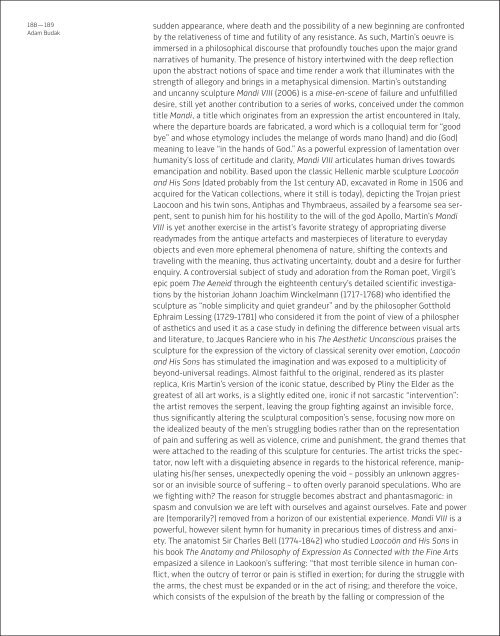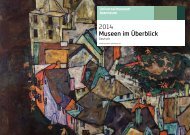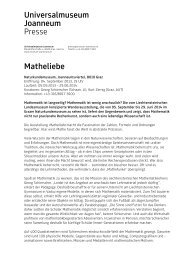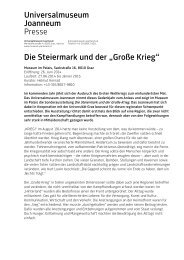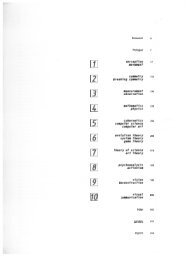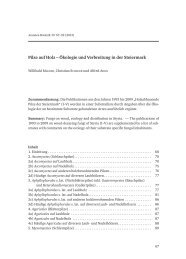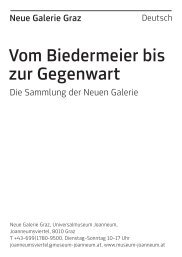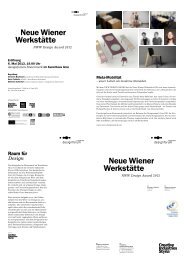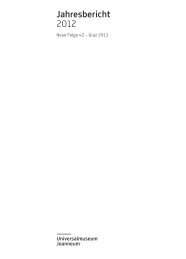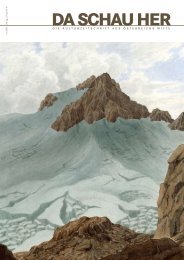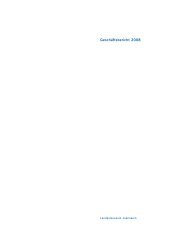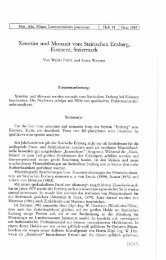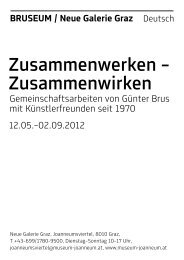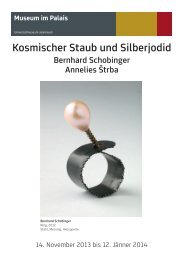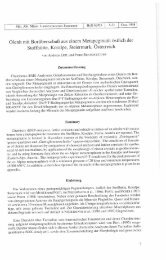Human Condition - Universalmuseum Joanneum
Human Condition - Universalmuseum Joanneum
Human Condition - Universalmuseum Joanneum
Erfolgreiche ePaper selbst erstellen
Machen Sie aus Ihren PDF Publikationen ein blätterbares Flipbook mit unserer einzigartigen Google optimierten e-Paper Software.
188 — 189<br />
Adam Budak<br />
sudden appearance, where death and the possibility of a new beginning are confronted<br />
by the relativeness of time and futility of any resistance. As such, Martin’s oeuvre is<br />
immersed in a philosophical discourse that profoundly touches upon the major grand<br />
narratives of humanity. The presence of history intertwined with the deep reflection<br />
upon the abstract notions of space and time render a work that illuminates with the<br />
strength of allegory and brings in a metaphysical dimension. Martin’s outstanding<br />
and uncanny sculpture Mandi VIII (2006) is a mise-en-scene of failure and unfulfilled<br />
desire, still yet another contribution to a series of works, conceived under the common<br />
title Mandi, a title which originates from an expression the artist encountered in Italy,<br />
where the departure boards are fabricated, a word which is a colloquial term for “good<br />
bye” and whose etymology includes the melange of words mano (hand) and dio (God)<br />
meaning to leave “in the hands of God.” As a powerful expression of lamentation over<br />
humanity’s loss of certitude and clarity, Mandi VIII articulates human drives towards<br />
emancipation and nobility. Based upon the classic Hellenic marble sculpture Laocoön<br />
and His Sons (dated probably from the 1st century AD, excavated in Rome in 1506 and<br />
acquired for the Vatican collections, where it still is today), depicting the Trojan priest<br />
Laocoon and his twin sons, Antiphas and Thymbraeus, assailed by a fearsome sea serpent,<br />
sent to punish him for his hostility to the will of the god Apollo, Martin’s Mandi<br />
VIII is yet another exercise in the artist’s favorite strategy of appropriating diverse<br />
readymades from the antique artefacts and masterpieces of literature to everyday<br />
objects and even more ephemeral phenomena of nature, shifting the contexts and<br />
traveling with the meaning, thus activating uncertainty, doubt and a desire for further<br />
enquiry. A controversial subject of study and adoration from the Roman poet, Virgil’s<br />
epic poem The Aeneid through the eighteenth century’s detailed scientific investigations<br />
by the historian Johann Joachim Winckelmann (1717-1768) who identified the<br />
sculpture as “noble simplicity and quiet grandeur” and by the philosopher Gotthold<br />
Ephraim Lessing (1729-1781) who considered it from the point of view of a philospher<br />
of asthetics and used it as a case study in defining the difference between visual arts<br />
and literature, to Jacques Ranciere who in his The Aesthetic Unconscious praises the<br />
sculpture for the expression of the victory of classical serenity over emotion, Laocoön<br />
and His Sons has stimulated the imagination and was exposed to a multiplicity of<br />
beyond-universal readings. Almost faithful to the original, rendered as its plaster<br />
replica, Kris Martin’s version of the iconic statue, described by Pliny the Elder as the<br />
greatest of all art works, is a slightly edited one, ironic if not sarcastic “intervention”:<br />
the artist removes the serpent, leaving the group fighting against an invisible force,<br />
thus significantly altering the sculptural composition’s sense, focusing now more on<br />
the idealized beauty of the men’s struggling bodies rather than on the representation<br />
of pain and suffering as well as violence, crime and punishment, the grand themes that<br />
were attached to the reading of this sculpture for centuries. The artist tricks the spectator,<br />
now left with a disquieting absence in regards to the historical reference, manipulating<br />
his/her senses, unexpectedly opening the void – possibly an unknown aggressor<br />
or an invisible source of suffering – to often overly paranoid speculations. Who are<br />
we fighting with? The reason for struggle becomes abstract and phantasmagoric: in<br />
spasm and convulsion we are left with ourselves and against ourselves. Fate and power<br />
are (temporarily?) removed from a horizon of our existential experience. Mandi VIII is a<br />
powerful, however silent hymn for humanity in precarious times of distress and anxiety.<br />
The anatomist Sir Charles Bell (1774-1842) who studied Laocoön and His Sons in<br />
his book The Anatomy and Philosophy of Expression As Connected with the Fine Arts<br />
empasized a silence in Laokoon’s suffering: “that most terrible silence in human conflict,<br />
when the outcry of terror or pain is stifled in exertion; for during the struggle with<br />
the arms, the chest must be expanded or in the act of rising; and therefore the voice,<br />
which consists of the expulsion of the breath by the falling or compression of the


